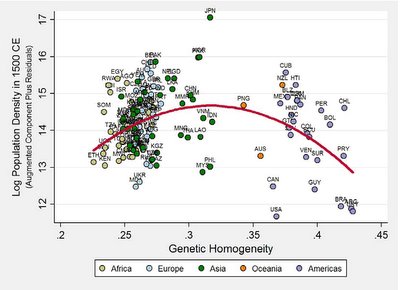From
Oded Galor and his promising grad student Quamrul Ashraf,
another paper that ties together genes and group productivity.
Their big result (Figure 5 below) is that a population cluster's genetic heterozygosity has a Goldilocks relationship with population density in 1500AD: Too much heterozygosity (Sub-Saharan Africa) or too little heterozygosity (Americas) predicts low population density. And in a pre-modern world (heck, even in the
modern world), population density is a rough measure of technological progress.

Surprisingly, the Goldilocks result holds even when you control for a bunch of other stuff like arable land and the timing of a population's agricultural transition. And perhaps most surprisingly, the much-hyped correlation between latitude and population density vanishes when you control for pretty much anything in addition to latitude. So the "distance from the equator" variable that growth economists spend
so much time on may just be epiphenomenal.
The authors admit they don't have a great theory for why the warm porridge tastes best–the goal of their paper is basically to get the Goldilocks result out there for others to work on. Here's hoping some economists take the bait.....
Bonus: Portfolio's Zubin Jelveh
gets Galor to comment on what all this means for Jared Diamond.
Labels: Economics, Genetics

